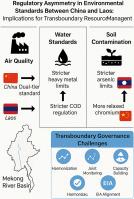跨国界环境政策协调:以中国-老挝监管差异为例
Q2 Environmental Science
引用次数: 0
摘要
环境标准对于管理跨界资源至关重要,特别是在经济迅速一体化的区域。本研究探讨了中国和老挝之间的环境治理差距,两国的双边关系通过中老铁路等重大基础设施项目得到加强。尽管日益相互依赖,但很少有研究对两国的环境标准进行比较。本研究通过分析它们在空气质量、水资源和土壤污染方面的监管框架,解决了这一差距。研究结果表明,在污染物阈值、监管严格程度和实施机制方面存在巨大差异。在空气质量方面,中国采用双层体系来适应区域污染水平,而老挝遵循世界卫生组织的指导方针,但对二氧化硫等主要污染物缺乏可执行的限制。在水标准方面,老挝对原始水实施了更严格的化学需氧量(COD)阈值,但允许更高的营养物质浓度,而中国由于其工业遗产而对汞等重金属施加了更严格的限制。对于土壤污染,老挝维持更严格的砷限制,但允许明显较高的铬含量,这反映了其采矿部门的经济影响。这些不一致给湄公河流域等共享生态系统的跨境环境管理带来了挑战,增加了监管套利的风险,阻碍了数据协调和联合治理。该研究得出结论,有效的跨境环境治理将需要统一的污染物标准、协调的监测系统、能力建设努力和统一的环境影响评估方法,以确保“一带一路”等走廊的可持续发展。本文章由计算机程序翻译,如有差异,请以英文原文为准。

Harmonizing environmental policy across borders: A case study of China–Laos regulatory disparities
Environmental standards are crucial for managing transboundary resources, especially in regions undergoing rapid economic integration. This study explores the environmental governance gap between China and Laos, whose bilateral relationship has intensified through major infrastructure projects like the China-Laos Railway. Despite growing interdependence, little research has examined the comparative environmental standards between the two countries. This study addresses that gap by analyzing their regulatory frameworks on air quality, water resources, and soil contamination. Findings indicate substantial disparities in pollutant thresholds, regulatory stringency, and implementation mechanisms. In air quality, China adopts a dual-tier system to accommodate regional pollution levels, while Laos follows WHO guidelines but lacks enforceable limits for key pollutants such as SO₂. In water standards, Laos enforces stricter chemical oxygen demand (COD) thresholds for pristine water but allows higher nutrient concentrations, whereas China imposes tighter limits on heavy metals like mercury due to its industrial legacy. For soil contamination, Laos maintains more stringent arsenic limits but permits significantly higher chromium levels, reflecting the economic influence of its mining sector. These inconsistencies pose challenges for cross-border environmental management in shared ecosystems like the Mekong River basin, increasing the risk of regulatory arbitrage and hindering data harmonization and joint governance. The study concludes that effective transboundary environmental governance will require harmonized pollutant standards, coordinated monitoring systems, capacity-building efforts, and unified environmental impact assessment methods to ensure sustainable development along corridors like the Belt and Road Initiative.
求助全文
通过发布文献求助,成功后即可免费获取论文全文。
去求助
来源期刊

Environmental Challenges
Environmental Science-Environmental Engineering
CiteScore
8.00
自引率
0.00%
发文量
249
审稿时长
8 weeks
 求助内容:
求助内容: 应助结果提醒方式:
应助结果提醒方式:


